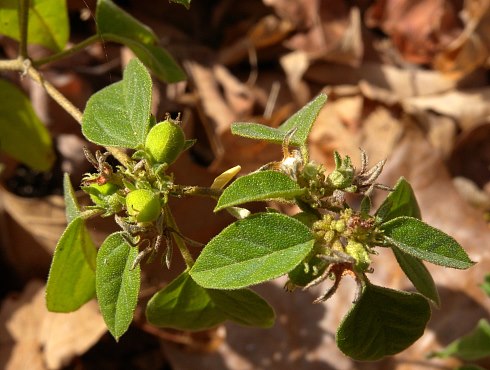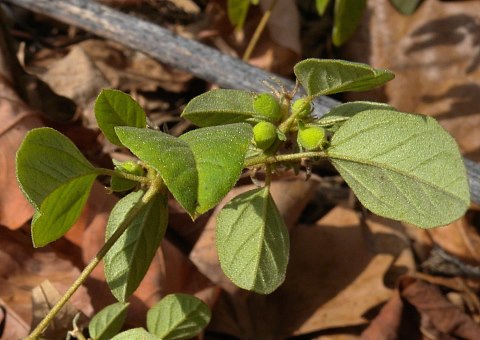Description: This plant is a summer annual up to 2' tall and 3' across. Robust specimens branch frequently and have a bushy appearance with a flattened top, while dwarf specimens on sterile ground branch relatively little; the latter can be less than 6" tall. The stems are covered with appressed hairs that shortly turn brown; the lower stem on robust specimens becomes rather stout. The leaves are usually alternate, although the uppermost leaves are often opposite. They are up to 2" long and ¾" across, broadly lanceolate-oblong, and smooth along the margins. The upper surface of each leaf is green and finely pubescent, while the lower surface is whitish green and woolly from appressed hairs. Many of these hairs are stellate (branched and star-like). The petiole of each leaf is about ½" in length. The foliage exudes a fetid aroma from glandular secretions; the leaves and stems have a clear sap. Prairie Tea is monoecious. The small male flowers occur in erect clusters from the axils of the upper leaves. Each male flower has a woolly green calyx with 5 lobes that are spreading and oblong, 3-8 narrow white petals, and 3-8 white stamens. Only a single female flower develops from each axil of the upper leaves. Each female flower has a woolly green calyx with 5 lobes that are spreading and oblong, a woolly green pistil that is ovoid in shape, a pair of cleft styles at its apex, and no petals. The blooming period occurs from mid-summer to early fall and lasts about 1-2 months. The female flowers are initially erect, but later droop downward as the seed capsules develop. Each ovoid seed capsule is up to ¼" long and contains a single seed that is rather large and finely pitted (less often, 2 seeds are produced). This plant spreads by reseeding itself.

Cultivation:
The
preference is full sun, dry conditions, and poor soil containing rocky
or gravelly material. The pH of the soil can be acid or alkaline. This
plant is quite drought resistant, although some of the lower leaves may
turn yellow and wither away. In more fertile soil, robust specimens are
produced that are bushy and attractive.
Range & Habitat:
The native Prairie Tea occurs occasionally in the southern half of
Illinois
(especially in the SW), but it is uncommon or absent elsewhere in the
state (see Distribution
Map). In the northern half of Illinois, this species is
probably adventive from the south, otherwise it is native. Habitats
include hill prairies, sandstone and limestone glades, thinly wooded
bluffs, fallow fields, and gravelly areas along railroads. This species
occurs in disturbed areas and higher quality habitats that are sunny
and dry.
Faunal Associations:
Little information is available about the insects that pollinate the
flowers, but they are probably small bees, flies, and/or wasps. The
caterpillars of Anaea andria (Goatweed Butterfly)
feed on the foliage of Prairie Tea and other Croton spp.
The large oily seeds of Croton spp. are attractive
to many upland gamebirds and some songbirds, including the Mourning
Dove, Wild Turkey, Prairie Chicken, Bobwhite, Cowbird, and various
sparrows. The fetid foliage is unattractive as a source of food for
mammalian herbivores, although goats will eat it. Sometimes, Croton
spp. are referred to as 'Goatweed' or 'Doveweed' because of
their value as a food source to these animals.

Photographic
Location:
Along an abandoned railroad in Vermilion County, Illinois.
Comments:
The foliage of Prairie Tea is reasonably attractive, while the flowers
are insignificant. The common name refers to the resemblance of robust
specimens to cultivated tea plants; however, the foliage is unsuitable
as a source of tea. Generally, Croton spp. are
typical prairie plants of the southern plains; they are less typical of
eastern tallgrass prairies, where they are often displaced by taller
vegetation in fertile areas. Prairie Tea differs from other Croton
spp. by the following characteristics: 1) Its leaves lack
teeth, 2) each seed capsule contains only a single seed (or at most
two), rather than three, 3) the female flowers are produced
individually from the leaf axils, rather than in groups, and 4) the
seed capsules do not exceed ¼" in length.